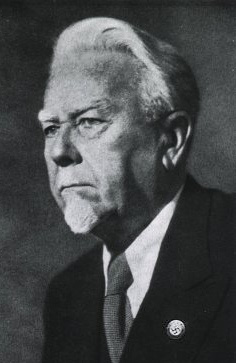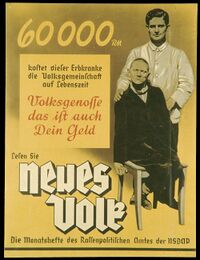Biography:Ernst Rüdin
Ernst Rüdin | |
|---|---|
 Ernst Rüdin, 1944 | |
| Born | 19 April 1874 |
| Died | 22 October 1952 (aged 78) |
Ernst Rüdin (April 19, 1874 in St. Gallen – October 22, 1952) was a Swiss-born German psychiatrist, geneticist, eugenicist and Nazi. Rising to prominence under Emil Kraepelin and assuming his directorship at what is now called the Max Planck Institute of Psychiatry in Munich. While he has been credited as a pioneer of psychiatric inheritance studies, he also argued for, designed, justified and funded the mass sterilization and clinical killing of adults and children.
Early career
Commencing in 1893, Rüdin studied medicine at universities in several countries, graduating in 1898. At the Burghölzli in Zurich, he worked as assistant to Eugen Bleuler who coined the term 'schizophrenia'. He completed his PhD, then a psychiatric residency at a Berlin prison[verification needed]. From 1907, he worked at the University of Munich as assistant to Emil Kraepelin, the highly influential psychiatrist who had developed the diagnostic split between 'dementia praecox' ('early dementia' – reflecting his pessimistic prognosis – renamed schizophrenia) and 'manic-depressive illness' (including unipolar depression), and who is considered by many to be the father of modern psychiatric classification.[1] Rüdin became senior lecturer in 1909, as well as senior physician at the Munich Psychiatric Hospital, succeeding Alois Alzheimer.[2]
Kraepelin and Rüdin were both ardent advocates of a theory that the German race was becoming overly 'domesticated' and thus degenerating into higher rates of mental illness and other conditions.[3] Fears of degeneration were somewhat common internationally at the time, but the extent to which Rüdin took them may have been unique, and from the very beginning of his career he made continuous efforts to have his research translate into political action. He also repeatedly drew attention to the financial burden of the sick and disabled.[4]
Rüdin developed the concept of "empirical genetic prognosis" of mental disorders. He published influential initial results on the genetics of schizophrenia (known as dementia praecox) in 1916.[5] Rüdin's data did not show a high enough risk in siblings for schizophrenia to be due to a simple recessive gene as he and Kraepelin thought, but he put forward a two-recessive-gene theory to try to account for this.[6] This has been attributed to a "mistaken belief" that just one or a small number of gene variations caused such conditions.[7] Similarly his own large study on Mood disorders correctly disproved his own theory of simple Mendelian inheritance and also showed environmental causes, but Rüdin simply neglected to publish and continued to advance his eugenic theories.[8] Nevertheless, Rüdin pioneered and refined complex techniques for conducting studies of inheritance, was widely cited in the international literature for decades, and is still regarded as "the father of psychiatric genetics".[9]
Rüdin was influenced by his then brother-in-law, and long-time friend and colleague, Alfred Ploetz, who was considered the 'father' of racial hygiene and indeed had coined the term in 1895.[10] This was a form of eugenics, inspired by social darwinism, which had gained some popularity internationally, as would the voluntary or compulsory sterilization of psychiatric patients, initially in America. Rüdin campaigned for this early on. At a conference on alcoholism in 1903, he argued for the sterilisation of 'incurable alcoholics', but his proposal was roundly defeated.[10] In 1904, he was appointed co-editor in chief of the newly founded Archive for Racial Hygiene and Social Biology, and in 1905 was among the co-founders of the German Society for Racial Hygiene (which soon became International), along with Ploetz.[11] He published an article of his own in Archives in 1910, in which he argued that medical care for the mentally ill, alcoholics, epileptics and others was a distortion of natural laws of natural selection, and medicine should help to clean the genetic pool.[3]
Increasing influence
In 1917, a new German Institute for Psychiatric Research was established in Munich (known as the DFA in German; renamed the Max Planck Institute of Psychiatry after World War II), designed and driven forward by Emil Kraepelin. The Institute incorporated a Department of Genealogical and Demographic Studies (known as the GDA in German) – the first in the world specialising in psychiatric genetics – and Rüdin was put in charge by overall director Kraepelin. In 1924, the Institute came under the umbrella of the prestigious Kaiser Wilhelm Society. From 1925, Rüdin spent three years as full Professor of Psychology at Basel, Switzerland.[11] He returned to the Institute in 1928, with an expanded departmental budget and new building at 2 Kraepelinstrasse, financed primarily by the American Rockefeller Foundation. The institute soon gained an international reputation as leading psychiatric research, including in hereditary genetics. In 1931, a few years after Kraepelin's death, Rüdin took over the directorship of the entire Institute as well as remaining head of his department.[4][7][12][13]
Rüdin was among the first to attempt to educate the public about the "dangers" of hereditary defectives and the value of the Nordic race as "culture creators".[14] By 1920, his colleague Alfred Hoche published, with lawyer Karl Binding, the influential "Allowing the Destruction of Life Unworthy of Living".[15]
In 1930, Rüdin was a leading German representative at the First International Congress for Mental Hygiene, held in Washington, US, arguing for eugenics.[11] In 1932, he became President of the International Federation of Eugenics Organizations. He was in contact with Carlos Blacker of the British Eugenics Society, and sent him a copy of pre-Nazi voluntary sterilization laws enacted in Prussia; a precursor to the Nazi forced sterilization laws that Rüdin is said to have already prepared in his desk drawer.[16]
From 1935 to 1945, he was President of the Society of German Neurologists and Psychiatrists (GDNP), later renamed the German Association for Psychiatry, Psychotherapy and Neurology (DGPPN).[17]
The American Rockefeller Foundation funded numerous international researchers to visit and work at Rüdin's psychiatric genetics department, even as late as 1939. These included Eliot Slater and Erik Stromgren, considered the founding fathers of psychiatric genetics in Britain and Scandinavia respectively, as well as Franz Josef Kallmann who became a leading figure in twins research in the US after emigrating in 1936.[4] Kallmann had claimed in 1935 that 'minor anomalies' in otherwise unaffected relatives of schizophrenics should be grounds for compulsory sterilization.
Rüdin's research was also supported with manpower and financing from the German National Socialists.
Nazi expert
In 1933, Ernst Rüdin, Alfred Ploetz, and several other experts on racial hygiene were brought together to form the Expert Committee on Questions of Population and Racial Policy under Reich Interior Minister Wilhelm Frick. The committee's ideas were used as a scientific basis to justify the racial policy of Nazi Germany and its "Law for the Prevention of Hereditarily Diseased Offspring" was passed by the German government on January 1, 1934. Rüdin was such an avid proponent that colleagues nicknamed him the "Reichsfuhrer for Sterilization"[2][18]
In a speech to the German Society for Rassenhygiene published in 1934, Rüdin recalled the early days of trying to alert the public to the special value of the Nordic race and the dangers of defectives. He stated: "The significance of Rassenhygiene racial hygiene did not become evident to all aware Germans until the political activity of Adolf Hitler and only through his work has our 30-year-long dream of translating Rassenhygiene into action finally become a reality." Describing it as a 'duty of honour' for society to help implement the Nazi policies, Rüdin declared: "Whoever is not physically or mentally fit must not pass on his defects to his children. The state must take care that only the fit produce children. Conversely, it must be regarded as reprehensible to withhold healthy children from the state."[14]
From early on, Rüdin had been a 'racial fanatic' for the purity of the 'German people'.[19] However, he was also described in 1988 as "not so much a fanatical Nazi as a fanatical geneticist".[20] His ideas for reducing new cases of schizophrenia would prove a total failure, despite between 73% and 100% of the diagnosed being sterilised or killed.[7]
Rüdin joined the Nazi party in 1937.[21] In 1939, on his 65th birthday, he was awarded a 'Goethe medal for art and science' handed to him personally by Hitler, who honoured him as the 'pioneer of the racial-hygienic measures of the Third Reich'. In 1944, he received a bronze Nazi eagle medal (Adlerschild des Deutschen Reiches), with Hitler calling him the 'pathfinder in the field of hereditary hygiene'.[11]
In 1942, speaking about 'euthanasia', Rüdin emphasised "the value of eliminating young children of clearly inferior quality". He supported and financially aided the work of Julius Duessen at Heidelberg University with Carl Schneider, clinical research which from the beginning involving killing children.[4][18][22][23]
Post-war
At the end of the war in 1945, Rüdin claimed he had only ever engaged in academic science, only ever heard rumours of killings at the nearby insane asylums, and that he hated the Nazis. However, some of his Nazi political activities, scientific justifications, and awards from Hitler were already uncovered in 1945 (as were his lecture handouts praising Nordics and disparaging Jews). Investigative journalist Victor H. Bernstein concluded: "I am sure that Prof. Rüdin never so much as killed a fly in his 74 years. I am also sure he is one of the most evil men in Germany." Rüdin was stripped of his Swiss citizenship which he had held jointly with German, and two months later was placed under house arrest by the Munich Military Government. However, interned in the US, he was released in 1947 after a 'denazification' trial where he was supported by former colleague Kallmann (a eugenicist himself) and famous quantum physicist Max Planck[verification needed]; his only punishment was a 500-mark fine.[24]
Speculation about the reasons for his early release, despite having been considered as a potential criminal defendant for the Nuremberg trials, include the need to restore confidence and order in the German medical profession; his personal and financial connections to prestigious American and British researchers, funding bodies and others; and the fact that he repeatedly cited American eugenic sterilization initiatives to justify his own as legal (indeed the Nuremberg trials carefully avoided highlighting such links in general). Nevertheless, Rüdin has been cited as a more senior and influential architect of Nazi crimes than the physician who was sentenced to death, Karl Brandt, or the infamous Josef Mengele who had attended his lectures and been employed by his Institute.[25]
After Rüdin's death in 1952, the funeral eulogy was held by Kurt Pohlisch, a close friend who had been professor of psychiatry at Bonn University, director of the second-largest genetics research institute in Germany, and expert Nazi advisor on Action T4.[26]
Rüdin's connections to the Nazis were a major reason for criticisms of psychiatric genetics in Germany after 1945.[5]
He was survived by his daughter, Edith Zerbin-Rüdin, who became a psychiatric geneticist and eugenicist herself. In 1996, Zerbin-Rüdin, along with Kenneth S. Kendler, published a series of articles on his work which were criticised by others for whitewashing his racist and later Nazi ideologies and activities (Elliot S. Gershon also notes that Zerbin-Rüdin acted as defender and apologist for her father in private conversation and in a transcribed interview published in 1988).[27][21] Kendler and other leading psychiatric genetic authors have been accused as recently as 2013 of producing revisionist historical accounts of Rüdin and his 'Munich School'. Three types of account have been identified: "(A) those who write about German psychiatric genetics in the Nazi period, but either fail to mention Rüdin at all, or cast him in a favorable light; (B) those who acknowledge that Rüdin helped promote eugenic sterilization and/or may have worked with the Nazis, but generally paint a positive picture of Rüdin's research and fail to mention his participation in the "euthanasia" killing program; and (C) those who have written that Rüdin committed and supported unspeakable atrocities."[28][29]
Partial bibliography
- Über die klinischen Formen der Gefängnisspsychosen, Diss. Zürich, 1901
- (Hrsg.) Studien über Vererbung und Entstehung geistiger Störungen, 1916–1939
- Psychiatrische Indikation zur Sterilisierung, 1929
- (Einl.) Gesetz zur Verhütung erbkranken Nachwuchses vom 14. Juli 1933, 1934
- (Hrsg.) Erblehre und Rassenhygiene im völkischen Staat, 1934
- Die Bedeutung der Eugenik und Genetik für die Psychische Hygiene. Zeitschrift für psychische Hygiene 3 (1930), S. 133–147
See also
- T-4 Euthanasia Program
- Ethnic cleansing
- Eugenics
- Nazi doctors (list)
- Racial hygiene
- Werner Heyde
- Werner Villinger
- Alfred Ploetz
References
- ↑ Kearney, Chris; Trull, Timothy J. (2014-02-11). Abnormal Psychology and Life: A Dimensional Approach. ISBN 9781305162792. https://books.google.com/books?id=U-nKAgAAQBAJ&pg=PA23.
- ↑ 2.0 2.1 Science and Inhumanity: The Kaiser-Wilhelm/Max Planck Society William E. Seidelman MD, 2001
- ↑ 3.0 3.1 Brüne, Martin (1 January 2007). "On human self-domestication, psychiatry, and eugenics". Philosophy, Ethics, and Humanities in Medicine 2 (1): 21. doi:10.1186/1747-5341-2-21. PMID 17919321.
- ↑ 4.0 4.1 4.2 4.3 Man, Medicine, and the State Pg 73-
- ↑ 5.0 5.1 Matthias M. Weber (1996). "Ernst Rüdin, 1874–1952: A German psychiatrist and geneticist". American Journal of Medical Genetics 67 (4): 323–331. doi:10.1002/(SICI)1096-8628(19960726)67:4<323::AID-AJMG2>3.0.CO;2-N. PMID 8837697.
- ↑ Gottesman, Irving I.; Shields, James (1982-06-30). Schizophrenia. CUP Archive. ISBN 9780521295598. https://archive.org/details/schizophreniaepi00gott.
- ↑ 7.0 7.1 7.2 Torrey EF, Yolken RH (September 2009). "Psychiatric Genocide: Nazi Attempts to Eradicate Schizophrenia". Schizophr Bull 36 (1): 26–32. doi:10.1093/schbul/sbp097. PMID 19759092.
- ↑ Kösters, Gundula; Steinberg, Holger; Kirkby, Kenneth Clifford; Himmerich, Hubertus (2015-11-06). "Ernst Rüdin's Unpublished 1922–1925 Study "Inheritance of Manic-Depressive Insanity": Genetic Research Findings Subordinated to Eugenic Ideology". PLOS Genetics 11 (11): e1005524. doi:10.1371/journal.pgen.1005524. ISSN 1553-7390. PMID 26544949.
- ↑ Models of Madness: Psychological, Social and Biological Approaches to Psychosis 2013. Eds. John Read, Jacqui Dillon. Pg 35. Citing Steeman (2005) & Straus (2006)
- ↑ 10.0 10.1 Racial Hygiene: Medicine Under the Nazis, 1988, by Robert Proctor. Pg 96–97
- ↑ 11.0 11.1 11.2 11.3 Who's Who in Nazi Germany Robert S. Wistrich, Routledge, 4 Jul 2013
- ↑ Ernst Klee: Das Personenlexikon zum Dritten Reich. Wer war was vor und nach 1945. Fischer Taschenbuch Verlag, Zweite aktualisierte Auflage, Frankfurt am Main 2005, ISBN:978-3-596-16048-8, S. 513.
- ↑ Psychiatric research and science policy in Germany: the history of the Deutsche Forschungsanstalt fur Psychiatrie (German Institute for Psychiatric Research) in Munich from 1917 to 1945 MM. Weber, 2000
- ↑ 14.0 14.1 The Science and Politics of Racial Research by William Tucker. University of Illinois Press, 1994. Pg121. Original transcript: E. Rudin, "Aufgaben and Ziele der Deutschen Gesellschaft fur Rassenhygiene," Archiv für Rassen- und Gesellschafts-Biologie 28 (1934): 228–29
- ↑ Understanding Mental Health: A Critical Realist Exploration By David Pilgrim
- ↑ The Eugenics Society, Its Sources and Its Critics in Britain Pauline Mazumdar, Routledge, 20 Dec 2005] Pg207
- ↑ Psychiatry under National Socialism: Remembrance and Responsibility Frank Schneider, 2011
- ↑ 18.0 18.1 The Missing Gene Jay Joseph, 2006, pg142-
- ↑ Peters UH (1996). "[Ernst Rüdin--a Swiss psychiatrist as the leader of Nazi psychiatry--the final solution as a goal]". Fortschr Neurol Psychiatr 64 (9): 327–43. doi:10.1055/s-2007-996402. PMID 8991870.
- ↑ Ethics and Mental Health: The Patient, Profession and Community Michael Robertson, Garry Walter, preface. Original source psychiatrist Robert Jay Lipton in 1988 book Nazi Doctors.
- ↑ 21.0 21.1 Elliot S. Gershon (1997). "Letter to the Editor: Ernst Rüdin, a Nazi psychiatrist and geneticist". American Journal of Medical Genetics 74 (4): 457–458. doi:10.1002/(SICI)1096-8628(19970725)74:4<457::AID-AJMG23>3.0.CO;2-G. PMID 9259388. https://zenodo.org/record/1235464.
- ↑ Medicine and Medical Ethics in Nazi Germany: Origins, Practices, Legacies Chapter by V. Roelcke, Pg106
- ↑ Program and practice of psychiatric genetics at the German Research Institute of Psychiatry under Ernst Rudin: on the relationship between science, politics and the concept of race before and after 1993 by V. Roelcke, 2002
- ↑ Genetic Research in Psychiatry and Psychology Under the Microscope Jay Joseph. Pg 33-, 48. Original source: Created Nazi Science of Murder Victor H Berstein, 1945, August 21, PM Daily
- ↑ From a Race of Masters to a Master Race: 1948 To 1848. A.E. Samaan, 8 Feb 2013.
- ↑ Baltic Eugenics: Bio-Politics, Race and Nation in Interwar Estonia, Latvia and Lithuania 1918–1940 : Volker Roelcke: 3. Eliot Slater and the Institutionalization of Psychiatric Genetics in the United Kingdom pg312 & note 71 on pg 323
- ↑ Edith Zerbin-Rüdin, Kenneth S. Kendler (1996). "Ernst Rüdin (1874–1952) and his genealogic-demographic department in Munich (1917–1986): An introduction to their family studies of schizophrenia". American Journal of Medical Genetics 67 (4): 332–337. doi:10.1002/(SICI)1096-8628(19960726)67:4<332::AID-AJMG3>3.0.CO;2-O. PMID 8837698.
- ↑ Joseph J, Wetzel NA (2013). "Ernst Rüdin: Hitler's Racial Hygiene Mastermind". J Hist Biol 46 (1): 1–30. doi:10.1007/s10739-012-9344-6. PMID 23180223.
- ↑ Understanding Mental Health: A Critical Realist Exploration David Pilgrim. Pg 51-
External links
- History of Mental Health: 1874: Ernst Rüdin By Henk van Setten
- The Simon Wiesenthal Center Multimedia Learning Center Online: Ernst Rudin (nb: page moved)
- International Eugenics
- Julian Schwarz, Burkhart Brückner: Biography of Ernst Rüdin in: Biographical Archive of Psychiatry (BIAPSY), 2016.





